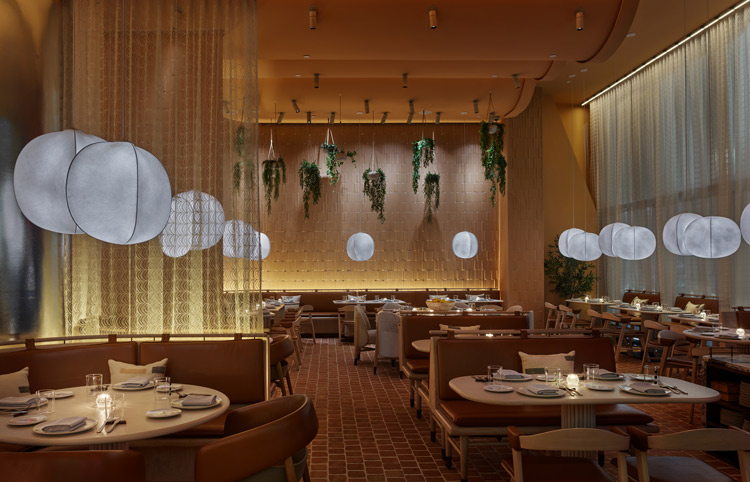How interior designers are incorporating cultural traditions and references
From indigenous crafts to subtle traditional aesthetics, these recent interiors show the transportive nature of incorporating different cultures into spaces.
Casa Dani, by Rockwell Group

Located within a 17-storey office building and serving local employees and neighbours is the new Casa Dani restaurant from Spanish Michelin-starred chef Dani Garcia. It forms part of a wider food market in New York’s Manhattan West.
Rockwell Group has developed the space, saying that the restaurant has been designed as a “progressive journey” which leads from a series of small, more intimate spaces into the restaurant’s showcase – a grand, double-height sunken dining room. Garcia’s homeland has been a creative reference throughout, the studio says.
As diners enter, the space is compressed and narrow – an undulating textured ceiling has been paired with parquet flooring in a bid to evoke a traditional Spanish villa, and walls filled with plants and olive oils further drive home the idea. The latter, hidden dining area features a Mediterranean colour and texture palette, filled with light woods, warm clay plaster, terracotta tiles and marble. It is a nod to open-air Spanish courtyards.
One of the stars of the show is the lighting. Inside the main dining room, Mori pendant lights from RBW hang above family-style round tables. The cool-toned light is a contrast to the surround warm palette, creating a lantern-like effect throughout.

SushiSamba Dubai, by ICRAVE

SushiSamba’s latest outpost in Dubai is located on the 51st floor of the Palm Tower, making it the highest restaurant on Palm Island. Designed by ICRAVE, the Japanese-Brazilian-Peruvian fusion restaurant is billed as a “destination in the clouds”.
In keeping with the fusion cuisine on offer, the 12,000sq foot space has allusions to all three countries. Traditional Japanese and Brazilian weaving techniques inform the expansive 3D-printed ceiling installation, which frames the whole restaurant. This is balanced with warm lighting and greenery.
At the centre of the space is a large theatre-style open kitchen and sushi bar. Also to be found is a 134-seat multi-level dining room fitted out with orange banquettes, and a 14-seat private dining room.
Much of the design has been implemented with a view to emphasize the scenery beyond the huge floor-to-ceiling windows surrounding the restaurant. The aim is to impart a “surreal, dream-like ambience against the immaculate panoramic horizon,” the studio says.

Isola by San Carlo, by Fettle

It might be located on London’s St Christopher’s Place, but the inspiration for the design of Isola by San Carlo comes straight from Sicily. Developed by Fettle, the project was inspired by the family heritage of the San Carlo brand and the native flora of the island.
The colour scheme of the space pays homage to Sicily’s most famous exports – with yellows representing lemons and greens representing pistachios. Also to be found are a number of different natural materials and finishes, like stone and Italian marble.
Certain elements, like the scalloped panelling found on the walls and ceiling, are nods to what one might find in a traditional grand Sicilian home. Other such elements include rattan furniture and wraps and an abundance of greenery.
As diners move from the front of the restaurant to the main dining area, the colour scheme changes from yellow and greens, to a warm light pink, with walls decorated with eclectic framed artworks, varied tabletop finishes and different styles of lamp and other accessories. The effect is comfortably homely, with a “sense of opulence”.

Orazio Palace, by Collidanielarchitetto

With its situation in the Prati district of Rome, it is no surprise that the design for Orazio Palace is inspired by the city and its history. Collidanielarchitetto says the city at night was the main reference for the project, as well as the neoclassical building itself.
No more so is this the case than with the top-floor Ozio Restaurant, which boasts large windows to showcase the city skyline uninterrupted. With this as the focal point of the space, the accompanying features have been chosen to compliment the scenery. Woven rope sofas and metal arm chairs contrast, while the dark marble finishes evoke a sense of history.
Elsewhere in the hotel, a traditional Italian courtyard has been modernised to provide respite from the city buzz. It features bright orange tables and seating, which stand out among the greenery and natural stone flooring.
The furniture found throughout the building is eclectic so as to appeal to the hotel’s wide clientele. Much is bespoke to the Orazio, including desks and bedside tables, sofas and small and large lamps.

The Maybourne Bar, by André Fu Studio

The first hospitality project completed by André Fu Studio in the US, the Maybourne Bar sits within the The Maybourne Beverly Hills hotel in Los Angeles. Fu calls the space “an elegant jewel-box of a bar”.
Fu says his inspiration for the bar’s design was the unification of different cultures – as such, for the Maybourne Bar, he sought to bring together Art Deco-style geometric patterns with vibrant Californian colours. High bar stools appear in bright blue and orange, against a monochrome Art Deco elements like wall panelling and black and white photography.
Aiming to create a “hidden jewel”, the bar itself is the focal point of the space. It has been carved from solid Turkish silver onyx and accented with polished nickel. It is accentuated by hidden lighting, which he says gives the bar “a seductive glow and sense of glamour”.
The theme of jewels and precious metals carries further into the room thanks to Fu’s intricate mosaic flooring, which features white Terrazzo and silver Emperador marble. Meanwhile the bespoke furniture is another nod to the Art Deco movement.
What has been your favourite recent interiors project? Let us know in the comments below…
-
Post a comment





